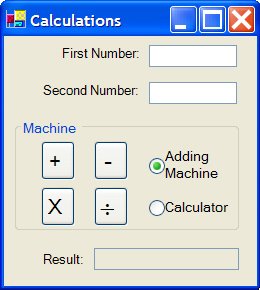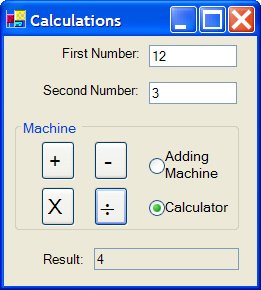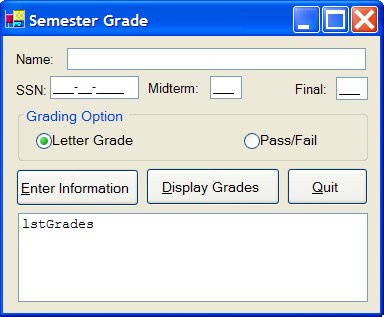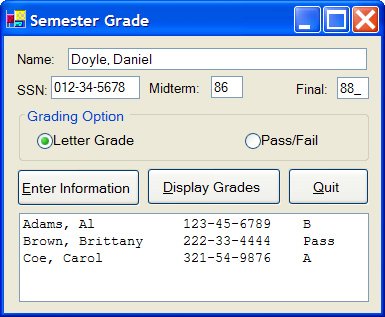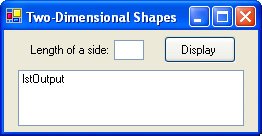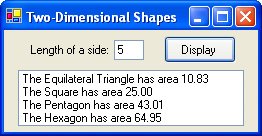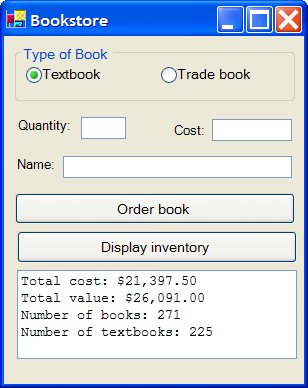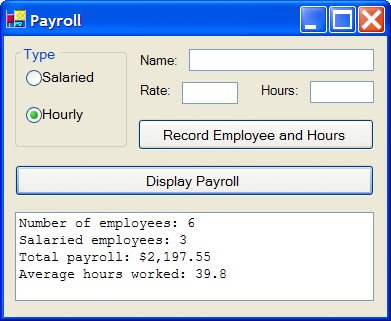Section 11.3. Inheritance
11.3. InheritanceThe three relationships between classes are "use," "containment," and "inheritance." One class uses another class if it manipulates objects of that class. We say that class A contains class B when a member variable of class A makes use of an object of type class B. Sections 11.1 and 11.2 present examples of use and containment. Inheritance is a process by which one class (the child or derived class) inherits the properties, methods, and events of another class (the parent or base class). The child has access to all of its parent's properties, methods and events as well as to all of its own. If the parent is itself a child, then it and its children have access to all of its parent's properties, methods and events. Consider the classes shown in Figure 11.6. All three children inherit Property A and Sub B from their parent. Child2 and Child3 have an additional event and a property, respectively. GrandChild1 has access to Property A, Sub B, and Event C from its parent and adds Function E and Sub F. The collection of a parent class along with its descendants is called a hierarchy. Figure 11.6. Example of inheritance hierarchy. There are two main benefits gained by using inheritance: First, it allows two or more classes to share some common features yet differentiate themselves on others. Second, it supports code reusability by avoiding the extra effort required to maintain duplicate code in multiple classes. For these reasons, inheritance is one of the most powerful tools of object-oriented programming. Considerable work goes into planning and defining the member variables and methods of the parent class. The child classes are beneficiaries of this effort. Just as structured programming requires the ability to break complex problems into simpler subproblems, object-oriented programming requires the skill to identify useful hierarchies of classes and derived classes. Software engineers are still working on the guidelines for when and how to establish hierarchies. One useful criterion is the ISA test: If one class is a more specific case of another class, the first class should be derived from the second class. The Visual Basic keyword Inherits identifies the parent of a class. The code used to define the class Parent and its child class Child2 as illustrated in Figure 11.6 is Class Parent Public Property A 'Property Get and Set blocks End Property Sub B() 'Code for Sub procedure B End Sub End Class Class Child2 Inherits Parent Event C() End Class As Child2 is itself a parent, its child GrandChild1 can be declared using a similar statement: Class GrandChild1 Inherits Child2 Function E() 'Code for function E End Sub Sub F() 'Code for Sub procedure F End Sub End Class Example 1. |
| In the following program, the user is presented with a basic adding machine. The Calculator class implements the Multiply and Divide methods and inherits the FirstNumber and SecondNumber properties and the Add and Subtract methods from its AddingMachine parent. When the Adding Machine radio button is selected, the user may add or subtract two numbers using an AddingMachine object. When the Calculator radio button is selected, the user may add, subtract, multiply, or divide two numbers using a Calculator object. Notice that the multiply and divide buttons are hidden when the Adding Machine is selected, and how the Click event procedures for the btnAdd and btnSubtract buttons examine the state of the radio button to determine which machine to use.
Public Class frmCalculate 'Create both machines. Dim adder As New AddingMachine() Dim calc As New Calculator() Private Sub rdoAddingMachine_CheckedChanged(...) _ Handles rdoAddingMachine.CheckedChanged 'Hide the multiply and divide functionality. btnMultiply.Visible = False btnDivide.Visible = False End Sub Private Sub rdoCalculator_CheckedChanged(...) _ Handles rdoCalculator.CheckedChanged 'Show the multiply and divide functionality. btnMultiply.Visible = True btnDivide.Visible = True End Sub Private Sub btnAdd_Click(...) Handles btnAdd.Click 'Add two numbers. If rdoAddingMachine.Checked Then 'If adding machine selected, use it to get the result. adder.FirstNumber = CDbl(txtNumber1.Text) adder.SecondNumber = CDbl(txtNumber2.Text) txtResult.Text = CStr(adder.Add) Else 'If calculator selected, use it to get the result. calc.FirstNumber = CDbl(txtNumber1.Text) calc.SecondNumber = CDbl(txtNumber2.Text) txtResult.Text = CStr(calc.Add) End If End Sub [Run, type in 12 and 3, and press the + and - buttons. Click the Calculator radio button, and press the +, -, x, and ÷ buttons.] |
Polymorphism and Overriding
The set of properties, methods, and events for a class is called the class interface. In essence, the interface of a class defines how it should behave. The interfaces of the classes AddingMachine and Calculator used in Example 1 are shown in Table 11.3.
Consider the classes used in Examples 1 and 2 of Section 11.1. Both Student and PFStudent have the same interface even though they carry out the task of computing a semester grade differently. See Table 11.4.
AddingMachine | Calculator | |
|---|---|---|
Properties | FirstNumber | FirstNumber |
SecondNumber | SecondNumber | |
Methods | Add | Add |
Subtract | Subtract | |
Multiply | ||
Divide | ||
Events | (none) | (none) |
Student | PFStudent | |
|---|---|---|
Properties | Name | Name |
SocSecNum | SocSecNum | |
midGrade | midGrade | |
Final | Final | |
Methods | CalcSemGrade | CalcSemGrade |
Events | (none) | (none) |
If a programmer wants to write a program that manipulates objects from these two classes, he or she need only know how to use the interface. The programmer need not be concerned with what specific implementation of that interface is being used. The object will then behave according to its specific implementation.
The programmer need only be aware of the CalcSemGrade method and needn't be concerned about its implementation. The feature that two classes can have methods that are named the same and have essentially the same purpose, but different implementations, is called polymorphism.
A programmer may employ polymorphism in three easy steps. First, the properties, methods, and events that make up an interface are defined. Second, a parent class is created that performs the functionality dictated by the interface. Finally, a child class inherits the parent and overrides the methods that require different implementation than the parent. The keyword Overridable is used to designate the parent's methods that can be overridden, and the keyword Overrides is used to designate the child's methods that are doing the overriding.
There are situations where a child class needs to access the parent class's implementation of a method that the child is overriding. Visual Basic provides the keyword MyBase to support this functionality.
Consider the code from Example 1 of Section 11.1. To employ polymorphism, the keyword Overridable is inserted into the header of the CalcSemGrade method in the Student class:
Overridable Function CalcSemGrade() As StringThe PFStudent class inherits all of the properties and methods from its parent, overriding the CalcSemGrade method as follows:
Class PFStudent Inherits Student Overrides Function CalcSemGrade() As String 'The student's grade for the semester If MyBase.CalcSemGrade = "F" Then Return "Fail" Else Return "Pass" End If End Function End Class
Example 2. (This item is displayed on pages 588 - 591 in the print version)
| In the following program, the user can enter student information and display the semester grades for the class. The PFStudent class inherits all of the properties from its parent Student, but overrides the CalcSemGrade method with its own implementation. The btnEnter_Click event procedure stores an element created by either class into the students array. However, the btnDisplay_Click event procedure does not need to know which elements are from which class, thus demonstrating polymorphism.
Public Class frmGrades Dim students(49) As Student 'Stores the class Dim lastStudentAdded As Integer = -1 'Last student added to students Private Sub btnEnter_Click(...) Handles btnEnter.Click 'Stores a student into the array. Dim pupil As Student 'Create the appropriate object depending upon the radio button. If rdoPassFail.Checked Then pupil = New PFStudent() [Enter the data, press the Enter Information button for three student, press the Display Grades button, and then enter the data for another student.] |
Example 2 employs inheritance and overriding to provide functionality to one child class. If a program contains two or more children of a class, however, the technique of overriding can lead to confusing programs. Visual Basic provides a cleaner design through the use of abstract classes.
Abstract Properties, Methods, and Classes
Sometimes you want to insist that each child of a class have a certain property or method that it must implement for its own use. Such a property or method is said to be abstract and is declared with the keyword MustOverride. An abstract property or method consists of just a header with no code following it. It has no corresponding End Property, End Sub, or End Function statement. Its class is called an abstract base class and must be declared with the keyword MustInherit. Abstract classes cannot be instantiated, only their children can be instantiated.
Example 3. (This item is displayed on pages 592 - 594 in the print version)
| The following program calculates the area of several regular two-dimensional shapes given the length of one side. (A regular shape is a shape whose sides have identical length and whose interior angles are identical.) The abstract parent class Shape implements the Length property and declares the Name and Area functions as MustOverride. Notice that methods declared with MustOverride do not have any implementation code. Each child class inherits the property from the parent and implements the two functions. The btnDisplay_Click event procedure uses polymorphism to set the shapes' length and display the shapes' names and areas.
Public Class frmShapes 'Declare shape array. Dim shape(3) As Shape Private Sub frmShapes_Load(...) Handles MyBase.Load 'Populate the array with shapes. shape(0) = New EquilateralTriangle() shape(1) = New Square() shape(2) = New Pentagon() shape(3) = New Hexagon() End Sub Private Sub btnDisplay_Click(...) Handles btnDisplay.Click Dim length As Double 'Set lengths of all shapes. length = CDbl(txtLength.Text) For i As Integer = 0 To 3 shape(i).Length = length Next 'Display results. lstOutput.Items.Clear() For i As Integer = 0 To 3 lstOutput.Items.Add("The " & shape(i).Name & " has area " _ & FormatNumber(shape(i).Area)) Next End Sub End Class MustInherit Class Shape Private m_length As Double 'Stores the value of Length property [Run the program, enter 5, and press the Display button.] |
Comments
Visual Basic uses inheritance in every Windows application that is written. Examination of any program's code reveals that the form's class inherits from the class System.Windows.Forms.Form.
In Example 2, the btnDisplay_Click event procedure does not need to know which elements of the Student array are instances of the Student class and which are instances of the PFStudent class. In some situations, however, the program may want to know this. Visual Basic provides the expression TypeOf...Is to test if an instance was created from a particular class (or from the class' parents, grandparents, etc.) For example, the following procedure counts the number of pass/fail students in the students array:
Sub CountPassFail() Dim count As Integer = 0 For i As Integer = 0 To lastStudentAdded If TypeOf students(i) Is PFStudent Then count += 1 End If Next MsgBox("There are " & count & " pass/fail students out of " _ & lastStudentAdded & " students in the class.") End Sub
Child classes do not inherit or have access to the parent's Private member variables.
Practice Problems 11.3
| 1. | In the class AddingMachine of Example 1, the Add function could have been defined with Function Add() As Double Return m_num1 + m_num2 End Function Explain why the Multiply function of the class Calculator cannot be defined with Function Multiply() As Double Return m_num1 * m_num2b End Function |
| 2. | Consider the hierarchy of classes shown below. What value is assigned to the variable phrase by the following two lines of code? Dim mammal As New Mammals() Dim phrase As String = mammal.Msg Class Animals Overridable Function Msg() As String Return "Can move" End Function End Class Class Vertebrates Inherits Animals Overrides Function Msg() As String Return MyBase.Msg & " " & "Has a backbone" End Function End Class Class Mammals Inherits Vertebrates Overrides Function Msg() As String Return MyBase.Msg & " " & "Nurtures young with mother's milk" End Function End Class Class Anthropods Inherits Animals Overrides Function Msg() As String Return MyBase.Msg & " " & "Has jointed limbs and no backbone" End Function End Class |
Exercises 11.3
In Exercises 1 through 4, identify the output of the code that uses the following two classes:
Class Square Overridable Function Result(ByVal num As Double) As Double Return num * num End Function End Class Class Cube Inherits Square Overrides Function Result(ByVal num As Double) As Double Return num * num * num End Function End Class
| 1. | Dim sq As Square = New Square() txtOutput.Text = CStr(sq.Result(2)) |
| 2. | Dim cb As Cube = New Cube() txtOutput.Text = CStr(cb.Result(2)) |
| 3. | Dim m As Square = New Square() Dim n As Cube = New Cube() txtOutput.Text = CStr(m.Result(n.Result(2))) |
| 4. | Dim m As Square = New Cube() txtOutput.Text = CStr(m.Result(2)) |
| 5. | Consider the class hierarchy in the second practice problem. What value is assigned to the variable phrase by the following two lines of code? Dim anthropod As New Anthropods() Dim phrase As String = anthropod.Msg |
| 6. | Consider the class hierarchy in the second practice problem. What value is assigned to the variable phrase by the following two lines of code? Dim vertebrate As New Vertebrates() Dim phrase As String = vertebrate.Msg In Exercises 7 through 16, identify the error in the code. |
| 7. | Class Hello Function Hi() As String Return "hi!" End Function End Class |
| 8. | Class Hello Function Hi() As String Return "hi!" End Function End Class Class Greetings Inherits Hi() Function GoodBye() As String Return "goodbye" End Function End Class |
| 9. | Class Hello Function Hi() As String Return "hi!" End Function End Class Class Aussie Inherits Hello Function Hi() As String Return "G'day mate!" End Function End Class |
| 10. | Class Hello Function Hi() As String Return "hi!" End Function End Class Class WithIt Inherits Hello Overrides Function Hi() As String Return "Hey" End Function End Class |
| 11. | Class Hello Overridable Function Hi() As String Return "hi!" End Function End Class |
| 12. | Class Hello MustOverride Function Hi() As String Return "hi!" End Function End Class Class DragRacer Inherits Hello Overrides Function Hi() As String Return "Start your engines!" End Function End Class |
| 13. | Class Hello MustInherit Function Hi() As String End Class Class Gentleman Inherits Hello Overrides Function Hi() As String Return "Good day" End Function End Class |
| 14. | Class Hello MustOverride Function Hi() As String End Class Class Euro Inherits Hello Overrides Function Hi() As String Return "Caio" End Function End Class |
| 15. | MustOverride Class Hello MustOverride Function Hi() As String End Class Class Southerner Inherits Hello Overrides Function Hi() As String Return "Hi y'all" End Function End Class |
| 16. | MustInherit Class Hello MustOverride Function Hi() As String End Class Class NorthEasterner Inherits Hello Overrides Function Hi(ByVal name As String) As String Return "How ya doin', "& name End Function End Class |
| 17. | Expand Example 1 to use a class ScientificCalculator that is derived from the class Calculator and has an exponentiation button in addition to the four arithmetic buttons. |
| 18. | Rewrite Example 2 so that the class Student has an abstract method CalcSemGrade and two derived classes called LGStudent (LG stands for "Letter Grade") and PFStudent. |
| 19. | Consider the class CashRegister from Exercise 25 of Section 11.1. Create a derived class called FastTrackRegister that could be used by at a toll booth to collect money from vehicles and keep track of the number of vehicles processed. Write a program using the class and having the form in Figure 11.7. One dollar should be collected from each car and two dollars from each truck. Figure 11.7. Form for Exercise 19. |
| 20. | Write a program that keeps track of a bookstore's inventory. The store orders both trade books and textbooks from publishers. The program should define an abstract class Book that contains the MustOverride property Price, and the ordinary properties Quantity, Name, and Cost. The Textbook and Tradebook classes should be derived from the class Book and should override property Price by adding a markup. (Assume that the markup is 40% for a trade book and 20% for a textbook.) The program should accept input from the user on book orders and display the following statistics: total number of books, number of textbooks, total cost of the orders, and total value of the inventory. (The value of the inventory is the amount of money that the bookstore can make if it sells all of the books in stock.) A sample output is shown in Figure 11.8. Figure 11.8. Sample output for Exercise 20. |
| 21. | Write a program that records the weekly payroll of a department that hires both salaried and hourly employees. The program should accept user input and display the number of employees, the number of salaried employees, the total payroll, and the average number of hours worked. The abstract class Employee should contain Name and Rate properties. (The Rate text box should be filled in with the weekly salary for salaried workers and the hourly wage for hourly workers.) The Salaried and Hourly classes should inherit the Employee class and override the method GrossPay that accepts the number of hours worked as a parameter. A sample output is shown in Figure 11.9. Hint: Use an array of a structure that holds the employee object and the number of hours worked during the week. Figure 11.9. Sample output for Exercise 21. |
| 22. | Consider the class Statistics from Exercise 26 of Section 11.1. Create a derived class called CompleteStats that also provides a Spread function and an event called NewSpread. This event should be raised whenever the spread changes. Write a program that uses the classes to analyze up to 50 exam grades input by the user. The program should display the number of grades and the current spread at all times. When the Calculate Average button is pressed, the program should display the average of the grades. A sample output is shown in Figure 11.10. |
Figure 11.10. Sample output for Exercise 22.
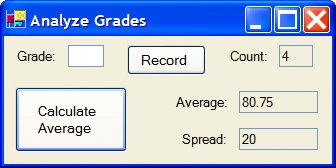
Solutions to Practice Problems 11.3
| 1. | While the derived class Calculator has access to the Properties and Methods of the base class AddingMachine, it does not have access to its Private member variables. |
| 2. | The string "Can move Has a backbone Nurtures young with mother's milk" |
EAN: 2147483647
Pages: 164

